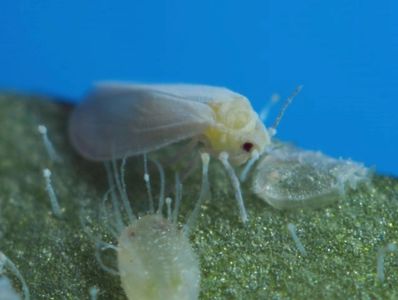WHITEFLIES
Biology and identification
Whiteflies are small, soft-bodied insects (approx. 1 mm long) that, like aphids, feed by sucking sap from the host plant, excreting excess sugars in the form of sticky ‘honeydew’. This way of feeding means that they do not create visible holes in plant tissues, but many of them can transmit plant viruses. In addition, whiteflies can serve to distribute broad mites, which have been known to cling to the legs of adult whiteflies and ‘hitch a ride’ to new plants.
Whitefly eggs are laid on host-plant leaves (often in a full or partial circular pattern), and hatch into a mobile ‘crawler’ stage that disperses to suitable feeding sites, where they settle and commence feeding; the later immature stages remain immobile in the same site, until the pupal stage eventually gives rise to the next generation of winged adults. The latter superficially resemble tiny moths, and will readily fly a short distance when infested leaves are disturbed.
In indoor crops, the 2 main pest whiteflies are the greenhouse whitefly (Trialeurodes vaporariorum) and the sweet potato whitefly (Bemisia tabaci). The latter is now thought to be not a single species, but rather a ‘species complex’ composed of more than 40 distinct cryptic species (sometimes referred to as ‘biotypes’) which cannot be distinguished by their external appearance, but which may differ in various aspects of their biology and behavior. Since the two main whitefly parasitoids differ in their preferences for these hosts, it is helpful to identify which whiteflies you have.
Identification (see pictures, below)
When viewed from above, the wings of adult T. vaporariorum are held relatively flat over the abdomen, creating a triangular ‘heart-shape’ with the insect’s head at its narrowest point, and the curved rear edges of the wings forming the two halves of the ‘heart’ (picture 1, below).
In contrast, the wings of B. tabaci adults are held at a much steeper angle over the body (similar to a pitched roof), with a visible gap between the two wings along the insect’s longitudinal axis (mid-line) (picture 3, below).
The pupal stages of T. vaporariorum can be recognized by the presence of long hairs (setae) around the margin (picture 2, below), whereas these hairs are absent from the pupae of B. tabaci (picture 4, below).

ADULTS AND PUPAE OF OF GREENHOUSE WHITEFLY (1 & 2) AND SWEET POTATO WHITEFL (3 & 4)

1. Adult greenhouse whitefly (Trialeurodes vaporariorum), viewed from above. Note 'heart-shape' formed by the two wings

2. Pupal stage of greenhouse whitefly (Trialeurodes vaporariorum), showing long marginal hairs (setae)

3. Adult of sweet potato whitefly (Bemisia tabaci), viewed from above. Note visible gap between the two wings

4. Pupal stage of sweet potato whitefly (Bemisia tabaci)
Copyright © 2022 Sierra Biological Inc. - All Rights Reserved.
Powered by GoDaddy
